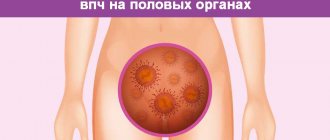Papillomas in intimate places in women are tumor-like formations on the skin and mucous membranes of the genital organs, resulting from infection with the human papillomavirus (HPV). About a hundred types of this virus are known, a third of which affect the genitourinary tract of men and women, causing the appearance of genital warts. HPV is transmitted primarily through sexual contact and can cause the growth of malignant tumors. Treatment of neoplasms combines surgical methods and systemic therapy. Specific prevention is carried out through vaccination.
Papillomas in the intimate area in women are a consequence of infection with the human papillomavirus
Causes of papillomas in the intimate area
Papillomas, or genital warts, in intimate places in women have a viral etiology. HPV is transmitted exclusively from person to person and leads to changes in the pattern of tissue growth. There are many types, or strains, of the virus that cause the growth of benign warts in women and provoke cancer of the vagina, cervix, and anus.
All strains of the virus are divided into groups according to their ability to induce malignant transformation of tissues.
| Degree of oncogenic risk | Type of human papillomavirus |
| Low | 3, 6, 11, 13, 32, 34, 40, 41, 42, 43, 44, 51, 61, 72, 73 |
| Average | 30, 35, 45, 52, 53, 56, 58 |
| High | 16, 18, 31, 33, 39, 50, 59, 64, 68, 70 |
The growth of genital warts in most cases is provoked by HPV strains 6 and 11.
Routes of infection
HPV is very easily transmitted from person to person. Entry into the body occurs in several ways.
| Method of infection | Description |
| Sexual | When genital warts occur in intimate places in women, this is the main method of infection. The virus can enter the body through oral-genital and anal contact. |
| Contact and household | The virus can survive for a short time in exfoliating skin cells, so the presence of damage to the skin and mucous membranes, even of a microscopic nature, allows viral particles to penetrate the human body. Infection occurs when visiting public toilets, swimming pools, baths, and gyms. |
| Autoinfection | The woman herself can spread the virus to new areas of the skin when shaving and epilating. This route of infection is also called autoinoculation. |
| From mother to child | The viral infection can be transmitted from mother to child during childbirth. This causes the appearance of papillomas in a newborn on the mucous membranes of the mouth, pharynx, genitals, and in the anus. |
The likelihood of infection increases in the presence of predisposing factors.
Symptoms in women and men
It is important to know what papillomas look like in intimate places, as well as their usual locations. Timely detection of pathological tissue growths will allow you to consult a doctor in a timely manner, thereby preventing the transformation of growths into malignant tumors.
Typical clinical signs of papillomavirus in intimate areas are the following:
- Common locations for growths in women are: mucous tissue of the vagina and cervix, labia majora and minora, and perineal area.
- In men, growths are located on the scrotum, head of the genital organ, and in the groin.
- The appearance of intimate growths may vary depending on the strain of the virus. More often, papillomas of this kind have a large, rough surface located on a relatively thin base, and therefore they are often compared to cauliflower forks or a cockscomb.
- The color of papillomas can also vary from flesh-colored to burgundy.
As a rule, the appearance of growths is not accompanied by pain or other unpleasant sensations, however, papillomas in the groin, if they come into contact with clothing during movements and walking, can cause a lot of inconvenience, get wet, and bleed. Constant damage to the growths can cause them to increase in size and transform into malignant tumors.
Probability of infection
HPV infection of the genitals and perineum is highly contagious, or contagious. Infection during a single sexual contact with a partner who has the virus occurs in six out of ten cases. The possibility of genital warts increases even more in the presence of a number of conditions.
| Predisposing factor | Characteristic |
| Young age | Most often, clinical signs of HPV infection appear in patients aged 20 to 24 years. In general, the age range from 17 to 33 years is the most likely for women in terms of the growth of papillomas in intimate areas. |
| Early sexual debut | Early onset of sexual activity, when the processes of hormonal changes have not yet been completed, is a factor that increases the risk of genital papillomatous formations. |
| Frequent change of sexual partners | A large number of sexual partners, frequent and promiscuous sexual contacts significantly increase the chances of contracting human papillomavirus infection. |
| Unprotected sexual contacts | Barrier contraception - the use of a condom - still remains the only easily accessible and relatively inexpensive means of possible, but not absolute, protection against HPV. It is impossible to completely get rid of the likelihood of infection with its help, since a condom may not isolate all contacting areas of damaged skin. But unprotected sexual intercourse is an almost guaranteed infection. Unprotected anal sex is an even greater risk factor, as it is often accompanied by microtrauma to the mucous membrane and skin. |
A combination of factors greatly facilitates the possibility of infection.
Forms of existence of HPV in the body
Once in the female body, the virus penetrates the epithelial cells of the skin and mucous membranes, where it can exist in two forms.
| Form of existence of HPV | Characteristic |
| Episomal | The inactive stage of virus development, which is considered benign. Viral particles are located outside the cell's chromosomes. Observed in asymptomatic carriers of the virus. It is observed in patients with good general body resistance. |
| Introsomal | The active stage of HPV development is regarded as a malignant form of parasitism of viral particles in the body. The virus integrates into the genome of epithelial cells and begins to control the cellular genetic material for the reproduction of HPV-encoded proteins, which leads to the appearance of clinical symptoms. |
Variants of the course of HPV infection
Contact with human papillomaviruses, even those dangerous in relation to cancer, does not always lead to the appearance of genital warts and the development of malignant diseases. Recovery may occur over a period of 6 to 12 months or long-term carriage without symptoms may occur. Papillomas in women appear in intimate places, and then quickly grow when the virus awakens. A decrease in the body’s defenses and the activation of HPV are promoted by:
- prolonged hypothermia;
- excessive physical and psycho-emotional stress;
- abuse of strong alcohol, smoking;
- viral, bacterial, fungal infectious diseases;
- traumatic injuries;
- pregnancy;
- malignant tumors;
- hormonal diseases;
- taking antibiotics, hormones, cytostatics.
In more than half of patients, characteristic growths in the genital area appear 1–3 months after intimate contact with a partner infected with HPV.
Symptoms
Genital papillomas in women can be single or multiple (see photo), small or large in size. Usually, during initial growth, they look like small flesh-colored or pink nodules, and later turn into growths in the form of papillae, similar in appearance to the comb of a rooster or cauliflower inflorescences. They are soft in consistency and have a so-called stem. Sometimes they grow up to several centimeters in diameter. The most common sites of localization in women:
- vaginal part of the cervix;
- walls and vaults of the vagina;
- labia;
- urethra;
- perineal skin;
- area around the anus;
- groin area.
Genital warts often exist asymptomatically. In this regard, women do not complain, especially with small lesions. Bleeding and weeping appear when the growths are traumatized, itching, pain, and sometimes an unpleasant odor - when ulceration and the addition of a secondary bacterial infection. Discomfort during urination occurs when papillomas are localized in the urethra, and during defecation - in the anus.
How does HPV manifest itself on the genitals?
Genital papilloma may look like a small bump, a hair from the epidermis, or a ball on a stalk. This can be a single growth or a group of formations in the intimate area, a flat wart or a large growth similar in shape to cauliflower. What unites them is their location - neoplasms appear in the anorectal area, in the perineum, on the scrotum and directly on the penis in men, on the labia and in the vagina in women.
Important: HPV strains that cause papillomas of the vagina, labia, scrotum and head of the penis rarely provoke the appearance of growths on the oral mucosa. These are papilloma viruses 6, 11, 16, 18, 33, 35 and some other types. Laboratory tests can determine the exact strain of the virus. Well, such a symptom as growths on the inside of the lips and cheeks should be a reason to consult a doctor.
Diagnosis of papillomas in intimate places in women
When genital warts appear in the genital area, patients usually turn to a dermatologist and gynecologist. When conducting diagnostics, the doctor:
- interviews the patient;
- studies the history of the development of the disease;
- examines the external genitalia;
- takes a cytological smear (scraping of cells from the cervical canal and vaginal part of the cervix for evaluation under a microscope);
- conducts a gynecological examination;
- performs a colposcopy (examination of the vagina, cervix and the initial part of the cervical canal using an optical device - a colposcope);
- takes material for histological examination if he suspects the malignant nature of the formation;
- recommends taking blood to determine HPV type using polymerase chain reaction (PCR);
- screens for sexually transmitted infections (STIs).
If genital papillomas located in the urethra are detected, an examination by a urologist and urethroscopy may be necessary. It is mandatory to screen your sexual partner for the presence of HPV and STIs.
Why are papillomas on the genitals dangerous?
The disease must be treated. This is a strong recommendation from both specialists from the World Health Organization and leading dermatologists-oncologists of Ukraine. In addition to the fact that papilloma on the labia or papilloma on the penis looks extremely unattractive, the disease, as mentioned above, is also dangerous.
Let's start small. When wearing tight underwear, during hygiene procedures, or during intimate caresses, the growth can be injured. And this is fraught with bleeding and secondary infection.
Important: The intimate area takes on an ugly appearance. This may cause disgust on the part of the sexual partner. Without treatment of the pathology, the area where the growths are located may increase. New areas of skin are gradually involved. The formations grow, over time they can interfere with urination and defecation.
If the outcome is unfavorable, HPV in the vagina and on the penis can take on a malignant form. A benign condyloma yesterday can become an oncological tumor with metastasis to the pelvic organs tomorrow. That is why you should not ignore the problem.
Important: Aggressive types of HPV cause cervical cancer, cancer of the small lips, vagina, penis and anus.
Treatment of genital papillomas
Therapy for genital papillomas should solve the following key problems:
- improve immunity;
- remove existing papillomas;
- prevent the appearance of new growths.
It is extremely difficult to completely get rid of papillomavirus due to its variability and significant species diversity, so treatment is predominantly symptomatic and restorative.
It is necessary to treat not only the woman, but also the sexual partner.
The main goal of therapy is to convert the virus into an inactive, or dormant, state.
| Medical direction | Ways to achieve |
| Boosting immunity | A decrease in the protective properties of the immune system contributes to the appearance of genital warts in the genital area in women. With good immunity, the body is able to cope with HPV contained in cells in 80-90% of cases within 24 months. The effectiveness of the local immune response can be increased with antiviral and immunomodulatory drugs: Interferon, Isoprinosine, Allokin-alpha, Cycloferon, Genferon, Epigen Intim, Lykopid, Aldara, Immunomax, etc. It is possible to use various dosage forms: injection solution, tablets, vaginal and rectal suppositories , ointments, creams, sprays. |
| Removal of papillomas | Therapy cannot be limited to just removing existing papillomatous growths. The patient should be treated comprehensively. The disappearance of small papillomas and regression of large papillomas can sometimes be achieved with immunostimulating and antiviral treatment. In addition, papillomatous formations should not be removed without systemic treatment, as this promotes infection of adjacent areas of the skin and mucous membranes, increasing the possibility of relapse. Removal of papillomas in intimate areas can be carried out in several ways: surgically, using alternating electric current, laser, liquid nitrogen, using coagulation with chemicals. |
| Prevention of HPV infection | A healthy lifestyle is a factor that helps increase nonspecific immunity, and it is necessary to reliably resist HPV infection. You should create the correct stereotype of sexual behavior: choose one sexual partner, avoid casual relationships, use a condom. For primary prevention, there is a vaccine called Gardasil, which is effective against HPV types 6, 11, 16 and 18. Vaccination is effective only for preventive purposes and is not intended to treat an existing disease. The best result is achieved if vaccination is carried out before the onset of sexual activity. Side effects when administering the vaccine are minor. |
Gardasil is a vaccine that allows you to protect against papillomavirus, which is responsible for the formation of papillomas in the intimate area
Genital condylomas of the perineum and external genitalia: choice of treatment method
V.A. Shaderkina Project Manager “Academy of Obstetrics and Gynecology”
Statistics
According to some data, 1% of sexually active people who sought medical help were found to have damage to the external genitalia in the form of papillomas and condylomas [1]. Other authors provide more serious statistics, arguing that the risk of HPV infection threatens 40-80% of sexually active adult women, and this applies to high-risk HPV. When infected with oncogenic strains of HPV, vulvar intraepithelial neoplasia (VIN) develops in 10% of cases, which, if left untreated, progresses over 1-4 years. The proportion of VIN has increased in recent decades and has been associated with HPV infection. [2]
About 90% of malignant diseases affecting the external genitalia and cervix, as well as the rectum in women, are associated with HPV, in particular HPV type 16 [3].
Etiology and diagnosis
The cause of the appearance of papillomas and condylomas, as mentioned above, is the human papillomavirus (HPV). In 1971, the HPV group was registered as a single species by the International Committee on Taxonomy of Viruses (ICTV); in 2003, this species was divided into 27 species from 5 genera (Alphapapillomavirus, Betapapillomavirus, Gammapapillomavirus, Mupapillomavirus and Nupapillomavirus) [4] and more than 170 types (strains). Currently, 600 strains are already known to cause diseases in humans, of which 40 strains can cause damage to the uro- and anogenital tract.
Some of the papillomas are benign, but there are strains of HPV that can induce neoplastic processes. Depending on this ability, oncogenic HPV strains are divided into oncogenic HPV strains of low, medium and high risks. A high risk of HPV-16 and 18 occurs in 70% of cases of cervical cancer. Also, oncogenic HPV strains are one of the main factors in the development of cancer of the glans penis in men [5].
Predisposing factors contributing to the exacerbation of HPV are traditionally considered to be numerous promiscuous sexual intercourse without the use of protection, organ transplantation and immunosuppressive therapy associated with it.
The diagnosis of papillomas can be made clinically; if an oncological lesion is suspected, histological confirmation is required. In 65% of people, the first clinical signs appear 90 days after contact with a sexual partner (skin-to-skin contact is crucial). Externally, genital condylomas have the appearance of papilloma-like formations on a narrow or wide base. Histologically - a picture of thickening of the epidermis, acanthosis, thickening and elongation of interpapillary wedges, koilocytosis of superficial keratinocytes.
Treatment method: the right choice
There is currently no radical therapy for papillomas resulting from complete elimination of the virus. As a rule, for benign lesions, treatment consists of one or another method of removing condylomas or papillomas. If the examination reveals a strain of a high oncogenic type, then general antiviral therapy can be added to the removal of the formations. If a malignant lesion develops, treatment is carried out in accordance with the principles of treatment of oncological diseases.
According to research by the US Centers for Disease Control and Prevention, natural immunity independently copes with the virus in the body within 2 years in 90% of cases [6]. The effectiveness of various treatment methods, taking into account repeated courses, is 60-80%. Relapses in 25-50% of cases develop during the first 3 months after treatment.
Invasive methods for removing papillomas/condylomas:
1. Surgical removal - combines all methods that use surgical equipment (cryotherapy, endoscopic methods, laser methods, etc.) and are aimed at removing or destroying the formation:
- electroexcision and electrocoagulation – excision and coagulation of formations. Electroexcision frees viruses within a radius of 20 mm from the center of the lesion.
- laser coagulation with carbon dioxide (CO2 laser) or neodymium laser - have both positive and negative properties. The advantages of this method include precision of tumor removal, accuracy and atraumaticity, speed of removal, absence of blood loss, short rehabilitation period. Laser removal may cause pain, which may require additional anesthesia. The level of individual pain threshold in a particular patient plays a big role in this.
The disadvantages of the method are the high cost of the procedure, especially the financial burden is high with multiple lesions. The impossibility of histological examination of the removed tissue complicates diagnosis when cancer is suspected. After the procedure, scars and tissue depigmentation may remain, which are of great importance for multiple papillomas. The possibility of recurrence cannot be excluded.
- cryodestruction with liquid nitrogen (application and aerosol) - the main disadvantages are insufficient precision of removal, inability to control the depth of exposure, the likelihood of repeated procedures and the formation of scars and deformations at the healing sites.
- photodynamic therapy - the essence of the effect is the activation of a photosensitizing substance under the influence of light, resulting in the formation of reactive oxygen species, which lead to tissue destruction and activation of the immune system. A photosensitizing agent (aminolevulinic acid) can be applied systemically or topically.
2. Conservative therapy
- Immunomodulators - interferon alpha injections - there is currently insufficient evidence that immunomodulatory therapy leads to a reduction in the risk of relapse and regression. Cases of complete or partial remission have been described with local application, injection into the lesion and systemic use of interferons. Although interferons are approved for use in genital warts in many countries, their widespread use is not recommended due to significant side effects.
- Cytostatics - the disadvantages of use are the high frequency of relapses and side effects.
- 5-fluorouracil - used in the form of a 5% cream, is an analogue of pyrimidine and blocks the transport of non-cellular thymidine, blocks the synthesis of DNA and RNA, preventing cell replication and proliferation. It has a teratogenic effect and is therefore strictly contraindicated during pregnancy. Some studies describe successful treatment in 76–85% of cases [7, 8].
- podophyllotoxin is an extract of the roots of the podophyllum plant with a cytostatic effect and tissue necrosis when applied topically. Apply 2 times a day after 12 hours, duration of treatment is no more than 5 weeks. Cannot be used to remove warts, age spots and birthmarks. Contraindicated during pregnancy.
- Chemical destruction - drugs are used:
- trichloroacetic acid is a caustic substance that causes a chemical burn of condylomas followed by necrosis. Scars, ulcers and secondary infection of necrotic tissues are quite common. It has no general toxicity and can be used during pregnancy.
- Solcoderm is an aqueous solution, the active component of which is the interaction products of organic acids (acetic, oxalic and lactic) and metal ions with nitric acid having a concentration of 6.6 N. The solution contains nitrites in an amount of 0.02 mg/ml. The low concentration of acids is the key to a low number of side effects [9]. No studies could be found on Medline for the previous 5-year period. All publications are typical for the 80-90s of the 20th century.
- imiquimod (Aldara - not registered in the Russian Federation) - stimulates the production of interferon, interleukin-12, tumor necrosis factor, stimulates cellular immunity. Its effectiveness and safety in the treatment of genital warts has been proven [10].
Today, the efforts of pharmaceutical companies are concentrated on the development and implementation of immunomodulatory drugs (Viferon, Cycloferon, Isoprinosine, Grosprinosin, Epigen and others) and searching for their place in the treatment of manifestations of the human papillomavirus.
One of the drugs in this group is Vartotsid (imiquimod) produced by the domestic Medical-Biological Research and Production Complex "Cytomed" (MBNPK "Cytomed"). The drug stimulates toll-like receptors (TLRs) of cells responsible for recognizing pathogen-associated molecular patterns. A distinctive feature of this drug is its ability to suppress angiogenesis by inhibiting the proliferation and migration of endothelial cells, which also contributes to the death of papillomas. The drug is convenient to use - the form of application in the form of a cream allows you to use it once a day, at night, every other day, until the condylomas completely disappear (but no more than 4 months). [11, 12].
The choice of treatment method for condylomas depends on the size, number, shape and location of the lesions. So, in the presence of large multiple papillomas (condylomas), it is advisable to carry out combined treatment - the use of destructive methods with maintenance therapy with immunomodulatory drugs. When the disease manifests itself in the form of spots, the use of Vartotsid is preferable, since its use causes minimal damage to surrounding tissues, and stimulation of antiviral immunity helps prevent its relapse.
Vartotsid’s evidence base already includes studies conducted at the Research Institute of Experimental Medicine of the Northwestern Branch of the Russian Academy of Sciences and the Medical-Biological Scientific and Production Complex “Cytomed” (St. Petersburg) [11, 12] and in the very near future will be replenished with new clinical observations that will be published in professional sources.
Key words: Genital condylomas, genital warts, exophytic condylomas, venereal warts - benign formations caused by the human papillomavirus (HPV), imiquimod, Vartotsid.
Bibliography : _
1. Am Fam Physician. 2014 Sep 1;90(5):312-8. Management of external genital warts. Karnes JB1, Usatine RP2 PMID: 25251091 2. Imiquimod-induced clearance of HPV is associated with normalization of immune cell counts in usual type vulvar intraepithelial neoplasia. Annelinde Terlou, Manon van Seters, Alex Kleinjan, Claudia Heijmans-Antonissen, Lindy A. M. Santegoets, Ilse Beckmann, Marc van Beurden, Theo J. M. Helmerhorst, Leen J. Blok. International Journal of Cancer, 127, 2831–2840 (2010) 3. Toll like receptor agonist imiquimod facilitates antigen-specific CD8+ T cell accumulation in the genital tract leading to tumor control through interferon-γ. Ruey-Shyang Soong, Liwen Song, Janson Trieu, Jayne Knoff, Liangmei He, Ya-Chea Tsai, Warner Huh, Yung-Nien Chang, Wen-Fang Cheng, Richard B. S. Roden, T.-C. Wu, Chien-Fu Hung, Clin Cancer Res. 2014 November 1; 20(21): 5456–5467. doi:10.1158/1078-0432.CCR-14-0344 4. To designate as species in the family Papillomaviridae:// ICTVonline. — Code assigned: 2003.224V. — 2003 5. Zhonghua Nan Ke Xue. 2013 Feb;19(2):178-81.Penile cancer and human papillomavirus infection. Zhai JP1, Wang JW, Man LB. PMID: 23441463 6. https://www.cdc.gov/std/HPV/STDFact-HPV.htm 7. J Drugs Dermatol. 2006 May;5(5):418-24. Topical 5% 5-fluorouracil cream in the treatment of plantar warts: a prospective, randomized, and controlled clinical study. Salk RS1, Grogan KA, Chang TJ. PMID: 16703777 8. Int J Dermatol. 2014 Sep;53(9):1145-50. doi: 10.1111/ijd.12505. Epub 2014 Jul 11. A comparison of a 5% potassium hydroxide solution with a 5-fluorouracil and salicylic acid combination in the treatment of patients with anogenital warts: a randomized, open-label clinical trial. Işik S1, Koca R, Sarici G, Altinyazar HC. PMID: 25039244 DOI: 10.1111/ijd.12505 9. Weiner M., Semah D., Schewach-Millet M. et al. Clin Pharmacol Ther 1983;33:77-83 10. Curr Probl Dermatol. 2014;45:175-85. doi: 10.1159/000356069. Epub 2014 Mar 13. Management of cutaneous human papillomavirus infection: pharmacotherapies. Ramírez-Fort MK1, Au SC, Javed SA, Loo DS. PMID: 24643186 DOI: 10.1159/000356069 11. Kuznetsova S. A., Starikova E. A., Freidlin I. S., Smirnov V. S. Changes in the function of human endothelial cells under the influence of imiquimod in vitro // Pharmacology and toxicology. – 2012. – T. 154. – No. 8. – P. 201-204 12. Smirnov V. S., Kudryavtseva T. A. Vartotsid (imiquimod). – St. Petersburg: Hippocrates, 2022. – 144 p.
Traditional methods
There are many folk recipes that allow you to get rid of papillomatous formations at home (which in no case should be torn off). For removal use: celandine, garlic, lemon juice, hydrogen peroxide. All of these products are dangerous for use in the intimate area. You should also remember that you cannot cure an infection simply by getting rid of visible growths. To combat the virus, systemic therapy is necessary, so it is better not to self-medicate, but to contact specialists immediately.
Removal of papilloma
Unfortunately, there is currently no universal cure for papillomas in intimate places. In addition, the viral infection is incurable, that is, with a single invasion, it remains in the body for life, periodically showing activity. However, it is still necessary to remove the external manifestations of the disease, that is, papillomas from the genitals, since there is a risk of developing malignant neoplasms.
There are many ways to remove intimate papillomas. To get rid of small tumors, it is enough to use antiviral agents for local action and oral administration. To remove large tumors, it may be necessary to use more radical measures, which include surgery, laser and radio wave therapy, cryodestruction, and many others.
Drug treatment
For small tumors, treatment of papillomas in intimate places, for example, in the groin area or on the genitals, can be done through the use of antiviral drugs. It is important to remember that the choice of the appropriate medication should be made only according to the recommendations of the attending physician.
The following products are particularly effective:
- Acyclovir. The product is presented in the form of tablets and ointments. It has a powerful antiviral effect, quickly suppressing the activity of pathogenic flora. In addition, its regular use to eliminate papillomas in intimate places helps to increase the body's protective functions.
- Oxolinic ointment. A simple but highly effective remedy for the treatment of papillomas. It can be used to remove small tumors.
- Panavir. A broad-spectrum medicine that helps increase the body’s resistance functions and suppress the activity of viral flora. It is recommended to use it to remove existing growths, as well as their reappearance.
- Viferon. One of the most effective immunomodulatory agents, which also has antiviral properties.
To effectively treat intimate papillomas, a specialist can prescribe the patient the complex use of two or more drugs.
The most common combinations of medications are complexes of products for internal and external use.
We should also talk about radical methods for removing papillomas in intimate areas.
If large growths are present on the skin and mucous membranes, the following methods for eliminating them are recommended:
- cryodestruction. The method involves exposing papillomas to liquid nitrogen, which literally freezes pathological tissue, promoting their destruction. Due to the somewhat painful nature of the method, the procedures are carried out using anesthetics.
- Electrocoagulation. One of the most effective methods, which involves removing tumors using high-frequency current. This method allows you to get rid of even large growths.
- Laser therapy. One of the most gentle methods, the use of which allows you to avoid the occurrence of inflammation and bleeding at the site of removal of the growth.
- Surgery. Removal of intimate papillomas using a scalpel is practiced quite rarely, since the use of this technique is fraught with the development of complications. More often, this method is used only for large tumors, the removal of which by minimally invasive methods is not possible.
The choice of a suitable treatment method for papillomas is made individually after examining the patient by a specialist. In case of significant damage to the skin, complex therapy can be used, combining invasive and medicinal methods of treatment.
Folk remedies
Procedures for removing papillomas on the genitals can be carried out independently using folk remedies. However, this is only permissible when the growths are small in size. In addition, before removing papilloma in intimate places at home, you need to consult a specialist.
The following methods are popular:
- aloe or kalanchoe juice. To obtain this antiviral agent, it is enough to grind several leaves of the selected plant to a pulp and squeeze out some juice using gauze. Next, you need to regularly apply fresh juice to the surface of the papillomas, as well as to healthy skin, which will help prevent the spread of infection.
- Propolis infusion. To remove growths, it is recommended to use pharmaceutical medicine. Using it is more than simple: to get the effect, it is enough to treat the growths at least three times throughout the day. It should be remembered that treatment of mucous tissues requires special care.
- Celandine juice. One of the most effective natural remedies for treating papillomavirus is fresh celandine juice. To remove tumors, it is enough to apply it to the surface of the growths. When processing, it is important to be careful not to get the product on healthy tissue, as this can cause severe burns.
Treatment of papillomas in intimate places with the help of folk remedies should be carried out until the growth is completely removed and the affected area is healed. You should know that even with small growths, treatment with home methods can take more than one week.
Features of treatment during pregnancy
Genital papillomas on a woman’s genitals, identified during the gestational period, can cause many problems. This is due to the fact that during pregnancy the use of most antiviral agents is not recommended. However, treatment is still recommended, since there is a high risk of infection of the fetus when passing through the birth canal.
If a woman has papillomas on her intimate organs, the use of invasive treatment methods is recommended. It is recommended to remove growths using a laser, radio wave technique, scalpel or other methods. It is important to remember that any manipulation is permissible only after receiving medical advice.










